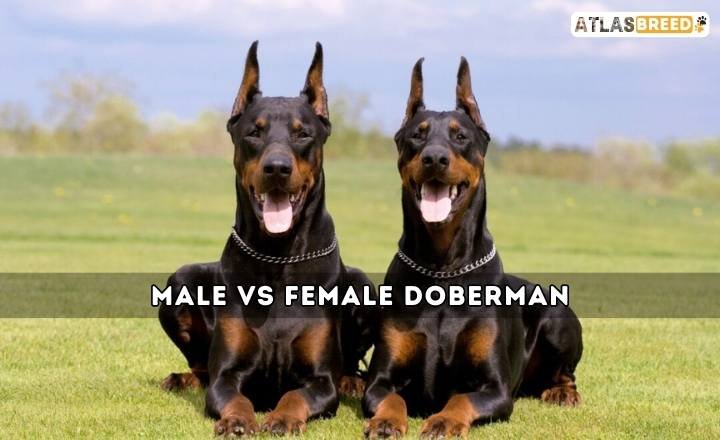When it comes to choosing a Doberman, potential owners often find themselves caught in the age-old debate: Male vs. Female Doberman. At first glance, these sleek and powerful dogs may seem like two sides of the same coin, but dig a little deeper and uncover distinct differences that can significantly impact your experience as an owner.
From temperament to training tendencies, each gender brings traits that can make or break your relationship with this intelligent breed. In this fascinating exploration of male versus female Dobermans, we’ll dissect their physical characteristics and their behavioral nuances.
Male vs Female Doberman Overview
| Height | Weight | |
| Female | 24-26 inches | 60-90 pounds |
| Male | 26-28 inches | 75-100 pounds |
| Lifespan | Temperament | |
| Female | 9-12 years | Serious, alert, less stubborn, cleaner overall |
| Male | 9-12 years | Playful, goofy, attention-seeking, less likely to get along with other dogs |
Dobies 101
Male Dobermans are often described as more affectionate and protective, typically forming a strong bond with their owners. This loyalty might manifest in an assertive nature, making them excellent guardians of home and family but sometimes leading to dominance issues if not well-trained.
On the other hand, female Dobermans tend to exhibit a more nurturing demeanor; they may be slightly less territorial but possess an incredible intuition about their owner’s mood. There are Doberman rescue houses available. This empathetic touch often makes them exceptional companions for families or individuals seeking emotional support.
Training dynamics also differ between genders. Males can be more stubborn, requiring consistent reinforcement due to their independent-minded nature; however, this trait can be turned into a rewarding challenge for dedicated trainers.
Female Dobies generally showcase greater eagerness to please during training sessions, which can lead to quicker learning—especially in social settings where obedience is vital.
Visual Differences Between The Male vs Female Doberman
Male Dobermans typically stand taller and are more robust, often tipping the scales at 75-100 pounds compared to females, who generally weigh between 60-90 pounds. This difference gives males a broader chest and a powerful gait, while females offer a sleeker appearance with their finer features and flatter skulls.

Beyond size, coat texture can also vary subtly between genders. Males may exhibit a slightly coarser coat due to hormonal differences, which can lead to variations in sheen; females often boast a soft luster that highlights their elegant silhouette.
The Girls
Female Dobermans showcase a more elegant silhouette, with softer features and a graceful demeanor. While still athletic, their bodies are often leaner, creating an impression of agility rather than brute force.
Males tend to have larger patches of tan on their snouts or legs, which enhance their rugged appearance. Females may exhibit smaller or more delicately placed markings that contribute to their refined charm.
The Boys
Male Dobermans typically exhibit a more robust physique—larger stature, broader heads, and more pronounced muscle mass give them a stately appearance. Their size often contributes to an imposing presence that some might find desirable for protective roles.
Beyond size, coat characteristics may differentiate the genders as well; while both males and females share the characteristic short, smooth coat of the breed, males often appear shinier due to increased intensity in grooming behavior tied to territorial marking.
Temperament And Personality
Regarding the temperament and personality traits of Doberman Pinschers, it’s crucial to consider the differences often observed between male and female dogs. Male Dobermans are typically more assertive and protective, often taking on a dominant demeanor. They tend to be more vocal and may exhibit a stronger inclination toward guarding behaviors, making them excellent watchdogs for families seeking an energetic protector.
Female Dobermans usually display a slightly gentler disposition, characterized by their nurturing instincts yet possessing fierce loyalty. They are often easier to train due to their eagerness to please their owners, which can make them exceptional companions in both family settings and individual lifestyles.
The Girlies
Female Dobermans often showcase a blend of independence and affection that is equally compelling. Their nurturing instincts typically emerge early on; they can be more attuned to emotional cues from their owners, resulting in deeper bonds formed over time.
The Boys
Male Dobermans tend to exhibit a more dominant, assertive nature, often resulting in a strong protective instinct toward their families. They are generally more playful and exuberant, which makes them ideal for active individuals or families who can engage in regular exercise and training.
Neutered Boys
Neutering can significantly influence the temperament and personality of male Dobermans, leading to notable differences when compared to their female counterparts. Neutered males often exhibit a more even-keeled demeanor, demonstrating reduced aggression and territorial behavior.
This change can make them more suitable as family pets, as they are typically less prone to engage in dominance-related disputes with other dogs or humans.
Training Differences In Male And Female Doberman
It’s essential to recognize that each gender has unique behavioral traits influencing their learning processes. Male Dobermans often exhibit a more assertive demeanor, which can contribute to a strong will and determination during training sessions.

This characteristic may require trainers to employ consistent leadership techniques, as males can be easily distracted by their surroundings or prone to enthusiasm that might overshadow commands.
Their nurturing instincts often translate into a heightened sensitivity towards human emotions, which can make them particularly responsive during training exercises. However, this intuition may also render females more susceptible to environmental stressors or changes in routine.
Female Dobies
Female Dobies often display a more nurturing disposition, making them highly responsive to positive reinforcement techniques. Their attentiveness allows for a nuanced understanding of commands, which can result in quicker obedience during training sessions.
Male Dobies
Male Dobies often display a more dominant and assertive nature, which can manifest in training sessions as a desire to take charge. This characteristic can sometimes lead to resistance against various commands unless there’s a strong, confident handler guiding their progress.
Male vs Female Doberman – Health
Males typically weigh more and have larger frames than females, which can sometimes lead to different health challenges. For instance, they may be at a higher risk for certain orthopedic issues due to their weight and muscle mass.
Females tend to mature faster than males both physically and mentally, which can influence training effectiveness; this maturity might result in fewer behavioral issues later on.
Von Willebrand Disease
This inherited bleeding disorder affects blood clotting due to a deficiency of von Willebrand factor, and while it does not discriminate by sex, subtle differences may influence how it manifests in each gender.
Research indicates that female Dobermans may exhibit more pronounced symptoms during heat cycles or pregnancy, escalating the risk of complications if vWD remains undiagnosed.
The expression of vWD can vary in severity between sexes. Male Dobermans are often diagnosed at earlier ages due to more frequent injuries from their generally active lifestyle. In contrast, females might endure delayed diagnosis since they may face fewer accidents but experience more covert signs like prolonged bleeding after routine procedures.
Gastric Dilatation
Gastric dilatation, often referred to as bloat, poses a significant risk for both male and female Dobermans, yet subtle differences in predisposition and anatomy can affect their vulnerability.
Male Dobermans are generally larger and may carry more weight, which could contribute to an increased risk of developing bloat due to the greater abdominal pressure during feeding. Conversely, female Dobermans might experience hormonal influences that can impact gastrointestinal motility, potentially altering their susceptibility.
Hypothyroidism
Hypothyroidism is a condition that can affect both male and female Dobermans, but there are subtle differences in how it manifests and impacts each gender. Male Dobermans tend to exhibit more pronounced symptoms, such as weight gain and lethargy, which can sometimes be mistaken for typical aging processes.
Female Dobermans may experience fluctuations in their reproductive cycles alongside hypothyroidism symptoms like dry skin or coat changes. This variance prompts owners to consider gender-specific health monitoring protocols.
Which Gender Is Right For You?
Male Dobermans are often seen as more dominant and protective, which can be beneficial for security purposes. They typically exhibit a strong desire to please their owners, frequently displaying more playful energy. On the flip side, females tend to be slightly calmer with a nurturing demeanor, making them exceptionally loyal companions who often bond closely with family members.
Conclusion
Both male and female Dobermans possess unique traits that may appeal to different owners based on their lifestyles and preferences. Males tend to be larger and more powerful, often exhibiting a protective nature, while females are generally smaller, more agile, and can display a nurturing temperament.
Training and socialization can vary between genders, influencing how each responds to commands and interacts with family members. Understanding these differences is crucial for potential Doberman owners in making an informed decision that aligns with their needs.
FAQs
Are male Dobermans cuddly?
Many Dobermans enjoy cuddling with their owners as they are known for their affectionate nature. They often seek physical closeness and enjoy being part of the family. Cuddling can be a way for them to show their love and bond with their owners.
What is the lifespan of a female Doberman?
This dog breed is healthy but can be prone to several health conditions over time. The average lifespan of a Doberman Pinscher is about 10-12 years.






